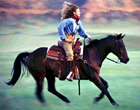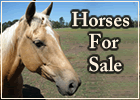

Improvements in Methods
Since Filming of this DVD
The Six Keys to Harmony DVD was filmed in 2004. I continue to learn more about the horse from the horse itself and from master horsemen of the past and present. To present ourselves and our ideas to the horse in the most acceptable way possible, I will continue to change and improve the methods I use to seek lightness and be more easily understood by the horse.
A. Praising –
Old Method – rubbing between the horse’s eyes
New Method –
Reward - rubbing on the neck and withers especially on the horse’s right side.
Release – turn your back to the horse so he sees that you are not asking anything of him but giving him time to completely relax and soak on the lesson you’ve just taught him.
I have found that rubbing a horse between the eyes often results in a slight negative reaction – the head raises and the ears go back slightly. Because of the horse’s eye placement, your hand disappears from his view about three inches from the horse’s face then your hand touches him without him being able to see it which can cause an unsettling surprise.
Some horses have become desensitized to this “human” touch and do not react negatively. Even so, being touched in this area is not natural for the horse. Between the eyes is not a location where horses touch each other. If you observe horses in the pasture together you will see them performing a “mutual grooming” routine in which they rub each other on the neck and withers with their muzzles.
If we want to be more acceptable to the horse, then we must be more like a horse and rub them where they are accustomed to being rubbed by other horses.
I do most of my rubbing and praising on the horse’s right side because we tend to do so many things on the horse’s left side – saddling, unsaddling, mounting, dismounting. The horse has grown accustomed to seeing the human from his left eye however some horses can become very nervous seeing the human on his right side. Some horses even try to block you and prevent you from being on their right side. They can develop a “right side issue” in which they constantly try to turn to keep the human in their left eye.
I spend plenty of time on the horse’s right side so I can have a balanced horse and show him that it is a good thing to have a human on his right side. I also make a point to sometimes saddle, unsaddle, mount and dismount on the horse’s right side. In case I am ever in a situation in which the circumstances or terrain force me to do these things on the horse’s right side, I want him to already be comfortable seeing me on that side.
B. Leading the hesitant horse–
Old Method – When leading, if the horse does not come along with you as you walk off, let the lead rope come across the front of your hips from your left hand and lean forward into the rope so you let the pressure from the halter encourage the horse to step forward.
New Method - When leading, if the horse does not come along with you as you walk off, do not pull on or tighten the rope. Simply step off to the side so the horse starts off in a slight turn then once the horse is moving, return to the straight line walking toward your original destination. By stepping to the side into a slight turn, you take the horse off balance which causes his feet to move. Once you have that movement then you can go anywhere with the horse following smoothly behind you.
I have found the more you pull on the lead rope, applying pressure to the horse’s head, the duller the horse becomes. It is as if they begin to say,” Just drag me anywhere you want me to go. I don’t have to think and pay attention anymore.”
C. Backing
Old Method –
Standing in front of the horse and wiggling the lead rope at him creating a side-to-side motion of the nose band of the halter which annoys him until he steps back.
New Method –
In the old method we are in essence driving the horse away from the hand, the rope (which can be compared to the rein) and the halter (which can be compared to the bridle). The hand on the rein is the primary aid, therefore the goal in horsemanship is that the horse learns to always trust the hand and the feel of the hand on the rein. Never drive the horse away from the hand, the rein or the bridle rather bring the horse to the hand, the rein and the bridle.
In the new method of backing we are using our core energy moving into the chest and shoulder of the horse. Feeling this pressure of our personal space and energy moving toward and into the personal space of the horse then the horse should melt away. Your hand should be just lightly holding the halter knot where the lead rope is attached. If the horse does not move backward from your energy and strong concentration on your mental visualization of his weight shifting to the rear and a hoof beginning to move backward, then slowly rock his head left and right to create a rhythm of movement. You may also need to release his jaw by slipping a finger of your other hand into the corner of his mouth and rubbing on his tongue or roof of his mouth. If the horse’s jaw is locked then he is holding tension in his upper neck and throughout his body. Releasing the jaw will help him relax so he can move calmly and easily.
D. Hindquarter yielding–
Old Method –
When you place your thumb on the horse’s side asking him to move the hindquarter away from you, if he ignores your thumb and does not move then begin to press your thumb into him deeper and harder until he moves away from your thumb in a sideways direction.
New Method –
Place the thumb on the horse’s side where your leg will swing back to when mounted, near the bottom of the last rib, with the lightest possible touch and never let it become heavier. If the horse ignores your touch and does not move then apply a series of secondary or support cues. The first phase of secondary pressure is to raise the end of the lead rope toward the hindquarter with energy and intent. Pause and let the horse read you. Next slap yourself on the back sharply with the end of the lead rope. Pause and let the horse read you. Then if the horse has not moved off your light thumb, bring the end of the lead rope down swiftly on the top of the horse’s hindquarter. The horse will most likely be surprised by the rope falling on it and will jump the hindquarter away. Horses are very good at memorizing a sequence or pattern so be consistent with the sequence of the support cue. You will find that the horse very quickly begins to choose an earlier cue and becomes lighter and more responsive.
In studying the most renowned French Riding Master of the Classical Era, Francois de la Guerieinre, he writes in his book Ecole de Cavalier, “The primary aid must never become heavy.” I realized I was making the primary aid heavier and heavier by pressing the thumb harder if the horse did not move.
Enjoy the Journey,

Ed Dabney is an internationally acclaimed clinician, presenting horsemanship and riding clinics all over the US and in Europe. In 2007, Ed was named Champion of the East Coast Trainer Challenge Series by Equine Extravaganza. Ed was honored to have been selected by the University of Georgia to teach their senior level Young Horse Training course.
His training articles have appeared in many major national magazines. Ed produces instructional videos and the “Gentle Horsemanship” TV program which has been seen on RFD-TV.
Ed's blending of natural horsemanship and classical equitation has made an indelible mark with students all across the United States and now also in Europe, drawing the attention of serious riders searching for the lightest touch and the deepest connection with their horses irrespective of breed or discipline.


